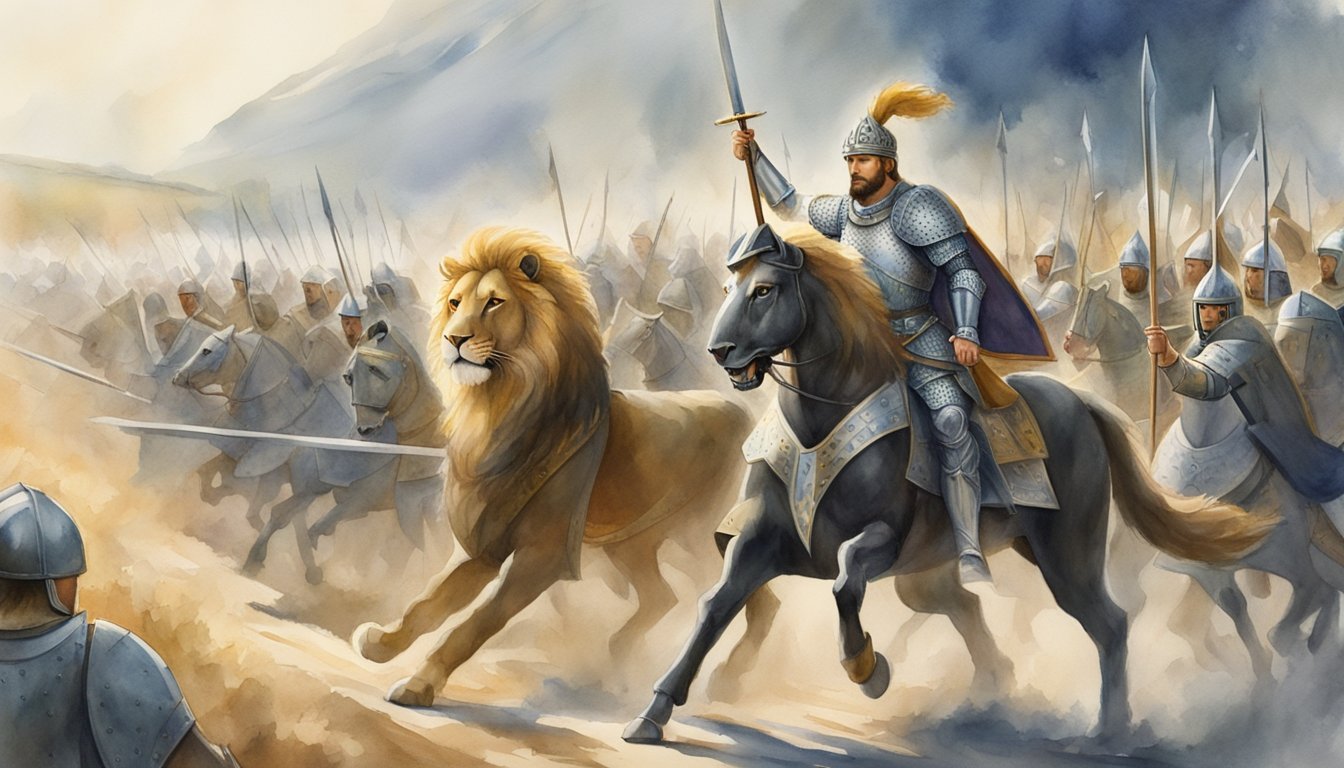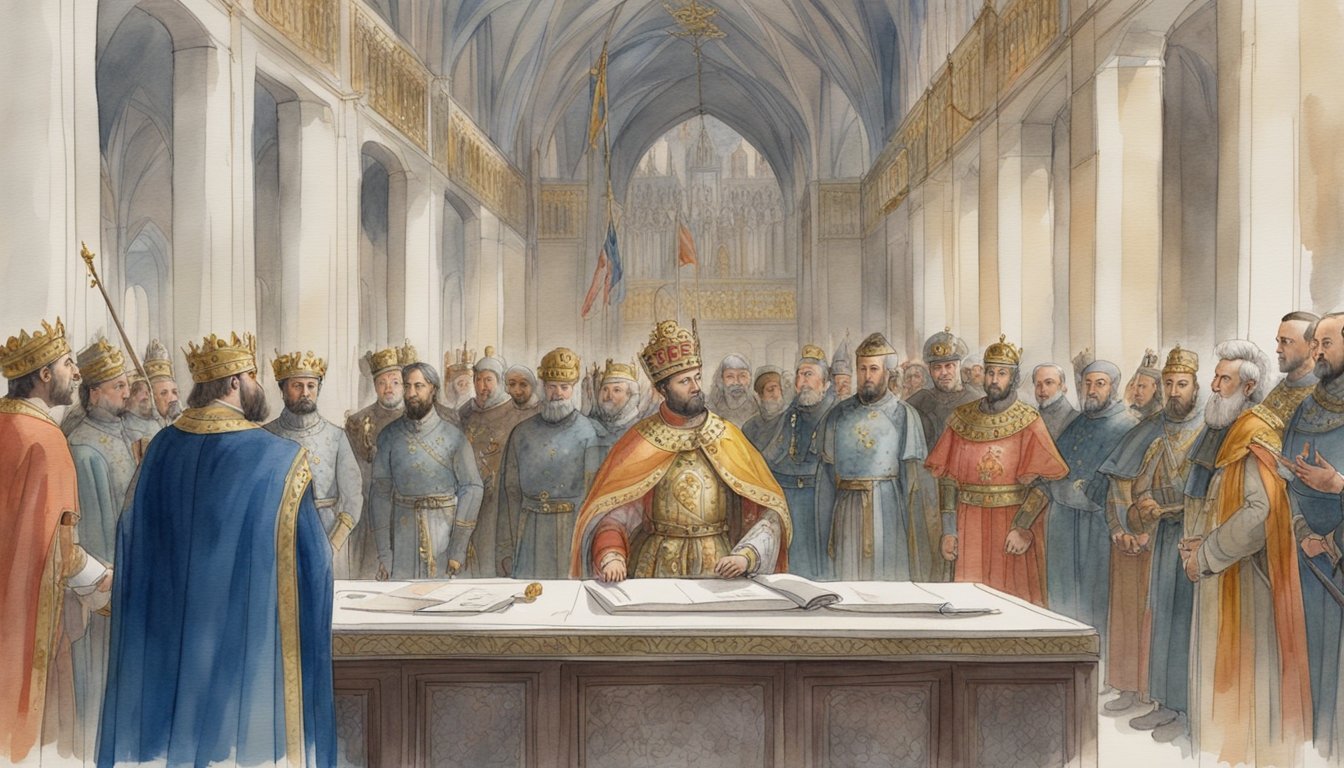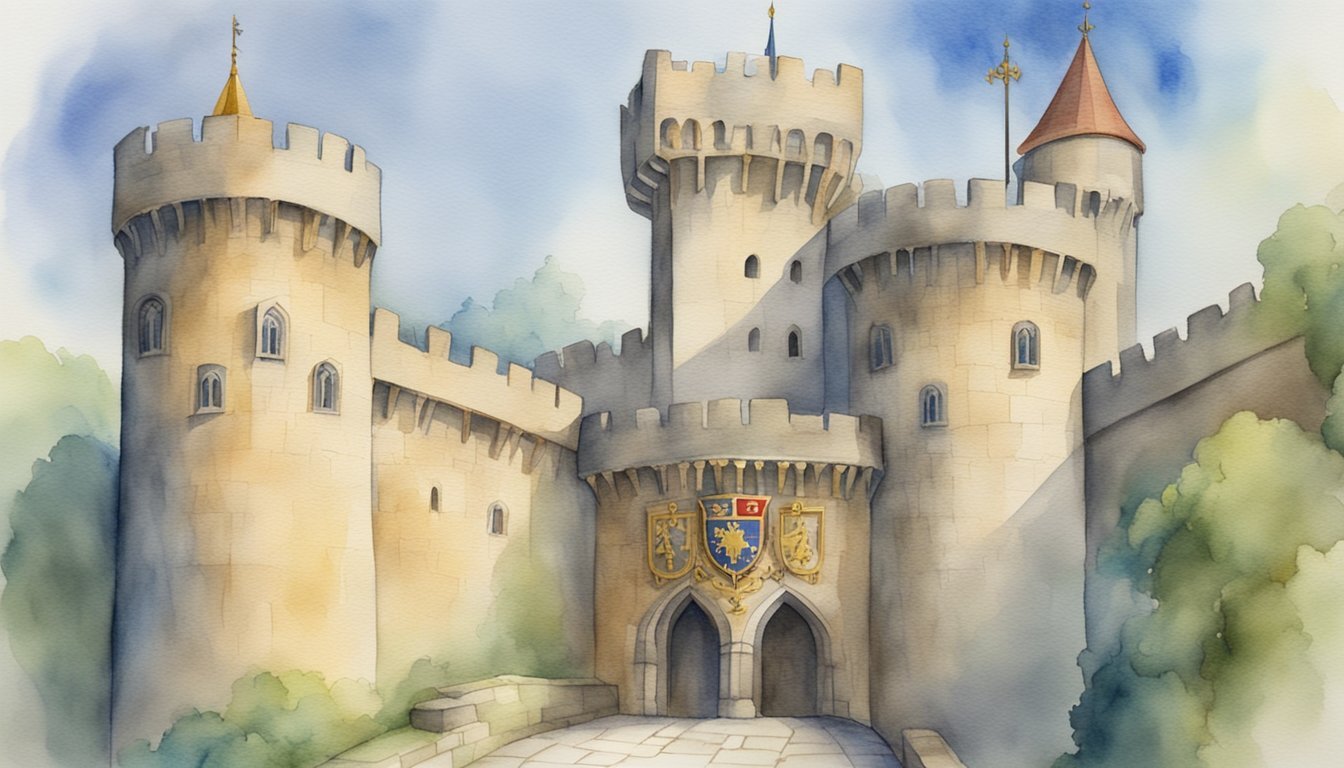Biography of Richard the Lionheart: The Brave King and Crusader

Richard the Lionheart, known for his fierce bravery and exceptional military leadership, remains one of England’s most legendary monarchs. He ruled as King of England from 1189 to 1199 and earned his famous nickname due to his relentless courage during the Third Crusade.
Born on September 8, 1157, in Oxford, Richard was the son of King Henry II and Eleanor of Aquitaine, and he quickly stood out with his ambition and warrior skills.

Richard’s journey to power was marked by his rise as Duke of Aquitaine and Count of Poitiers at a young age.
When he later ascended the throne, his focus turned to military campaigns and ensuring his authority across his territories.
His rule was largely characterized by his participation in the Third Crusade, where he gained legendary status among his peers and foes alike.
Even though Richard spent little time in England during his reign, his influence stretched far and wide.
He also found himself captured and held hostage during his return from the crusade.
Despite these challenges, Richard’s impact on medieval European politics and his legendary status as a warrior king continue to captivate historians and enthusiasts today.
For a deeper dive into the spiritual and mystical aspects that influenced many leaders of his time, check out these secret spiritual knowledge insights. 🛡️
Key Takeaways
- Richard the Lionheart ruled England from 1189 to 1199.
- He earned his nickname due to his bravery in the Third Crusade.
- His legacy as a warrior king continues to fascinate.
Early Life and Family

Richard the Lionheart, born into one of the most powerful families of the time, had a complex relationship with his parents and siblings.
His early years were shaped by noble heritage and intense familial dynamics.
Birth and Lineage
Richard I was born on September 8, 1157, in Oxford, England.
He was the third son of Henry II and Eleanor of Aquitaine.
His lineage included Anjou and Aquitaine, some of the most influential regions during his time.
Richard’s upbringing was heavily influenced by his mother, who was a formidable figure in her own right.
Eleanor was a previously married queen, bringing considerable territories and power to her marriage with Henry II.
This union made Richard and his siblings heirs to a vast empire.
Richard was known to be his mother’s favorite, adding to his prominent status within the family.
Relationship with Parents and Siblings
Richard’s relationship with his parents, Henry II and Eleanor of Aquitaine, was complicated.
Henry II had a rocky marriage with Eleanor, leading to multiple conflicts.
Richard often sided with his mother against his father, creating a family steeped in rivalry.
His siblings were Geoffrey, Henry, and John.
Richard joined a rebellion against his father alongside his brothers, showcasing the intense sibling dynamics. 📚 Geoffrey and Henry were both influential, but his youngest brother, John, later became a significant rival.
These familial tensions shaped Richard’s character and his future decisions as a leader.
You can learn more about the secret spiritual knowledge that influenced the royal family here.
Rise to Power
Richard the Lionheart’s journey to power involved securing key titles and rebelling against his own father.
His path to becoming the King of England is fascinating and marked by significant events.
Duchy of Aquitaine
Richard’s rise started with the Duchy of Aquitaine.
He inherited this region from his mother, Eleanor of Aquitaine, in 1168.
Aquitaine was a vast territory, rich and strategically important.
As the Duke, he was responsible for defending it and maintaining its prosperity.
Richard’s mother played a crucial role.
Eleanor, a powerful and influential figure, ensured that Richard was well-prepared and supported in ruling Aquitaine.
By taking control of the Duchy, Richard laid the groundwork for his future titles and responsibilities.
Managing Aquitaine wasn’t easy.
Richard faced challenges from rebellious barons and neighboring threats.
Yet, his strong leadership and military prowess helped him secure and stabilize the region.
This early experience in governance and war shaped his capabilities as a future king.
Rebellion Against Henry II
Richard’s relationship with his father, King Henry II, was strained.
Richard, along with his brothers, often rebelled against Henry.
These rebellions were partly driven by disputes over territories and power.
Richard wanted more control, and his father was reluctant to give it.
In 1173, he joined a major rebellion against Henry II, aligning with his brothers and French allies.
Though the rebellion initially faltered, Richard continued to challenge his father, showing his determination and ambition.
The tension between father and son reached new heights in the late 1180s.
Richard formed alliances with enemies of the King of England, including King Philip II of France.
Eventually, Henry II was forced to recognize Richard as his heir.
Richard’s persistence proved pivotal in his journey to the throne.
Additionally, it’s essential to understand the secret spiritual knowledge that influenced rulers of the time.
Gaining insight into these beliefs can provide a deeper understanding of Richard’s motivations and actions.
By rebelling against his father and securing control over key regions, Richard the Lionheart paved the way for his reign. 🦁
Military Campaigns
Richard the Lionheart is best known for his puissant military campaigns against prominent forces in France, Scotland, and the Holy Land.
His leadership and daring actions have made him a significant figure in medieval military history.
Conflict with France and Scotland
King Richard I, also known as the Lionheart, faced persistent disputes with France during his reign.
He held territories in Normandy and Aquitaine, which often led to clashes with the French king, Philip II.
Their rivalry intensified following Richard’s coronation.
In 1189, as Richard ascended to the English throne, tensions with Scotland also brewed.
The Scottish Borders witnessed uneasy truces and occasional skirmishes.
Richard’s primary aim was to secure his northern territories while keeping French ambitions in check.
His military acumen and diplomatic strategies often put him at an advantage, but the conflicts required constant attention and resources.
Expansion into the Holy Land
Richard’s most famous military campaign was the Third Crusade (1189-1192) 🌍.
Driven by a desire to reclaim Jerusalem, he joined forces with other European leaders.
He captured significant cities, including Acre and Arsuf, showcasing his strategic brilliance.
The battle at Acre was intense, with Richard demonstrating exceptional bravery.
His triumph at Arsuf against Saladin’s army boosted his reputation.
Though he achieved many victories, reclaiming Jerusalem eluded him.
Despite that, his efforts in the Holy Land solidified his legacy as a formidable crusader and military leader. 💂♂️
Captive King
Richard the Lionheart’s journey back from the Crusades was fraught with peril.
His capture and ransom became legendary events in medieval history.
Let’s dive into the key moments of his time as a captive king.
Capture and Imprisonment
Richard I, also known as Richard the Lionheart, faced trouble on his way back to England from the Third Crusade.
A storm forced him ashore near Venice.
Because of tensions with France, he was disguising himself to avoid capture.
Unfortunately, his efforts failed when Leopold of Austria discovered him near Vienna.
Leopold of Austria had grievances against Richard, partly because of conflicts during the Crusades and partly for political reasons.
Capturing such a high-profile figure was a significant victory for Leopold.
Richard was taken to the castle at Dürnstein on the Danube.
Later, Leopold handed him over to the German Emperor, Henry VI, who kept him imprisoned at various locations.
The conditions of his captivity were strict, and Richard’s whereabouts were often shrouded in secrecy.
Ransom and Return
Richard’s imprisonment led to one of the most famous ransoms in history.
Henry VI demanded a huge ransom for his release, amounting to 150,000 marks.
Richard’s mother, Eleanor of Aquitaine, played a crucial role in raising this enormous sum.
The people of England were heavily taxed to gather the funds.
The ransom negotiations took significant time.
During this period, several legends and stories about Richard’s captivity spread across Europe.
His supporters worked diligently to secure his release, showing immense loyalty to their king.
Once the ransom was paid, Richard was released in February 1194.
He journeyed back to England, where he received a hero’s welcome.
His return marked the end of a dramatic and challenging chapter in his life, allowing him to resume his responsibilities as king.
For those who want to explore more about the hidden aspects of spiritual knowledge, check out this link for some fascinating insights.
Marriage and Succession
Richard the Lionheart’s marriage to Berengaria of Navarre and his lack of a direct heir significantly impacted his reign and succession.
His time on the throne involved complex relationships and left a contested line of succession.
Wedding to Berengaria of Navarre
Richard married Berengaria of Navarre on May 12, 1191, in Cyprus 🏝️.
The wedding took place while he was on his way to the Third Crusade.
Berengaria was the daughter of Sancho VI of Navarre, making her a politically advantageous match.
Their marriage did not result in any children.
Berengaria accompanied Richard on his crusade, but after the campaign, she rarely saw him again.
Despite being married, their relationship appeared more strategic than affectionate.
Historians even debate whether the marriage was ever consummated.
Berengaria lived mostly in Europe, while Richard spent much of his time in military campaigns.
This separation played a significant role in the lack of an heir.
Lack of Heir
Richard’s failure to produce an heir led to significant complications.
Upon his death in 1199, the throne was contested.
The primary contenders were his younger brother, John, and his nephew, Arthur of Brittany.
John eventually became king, but Arthur, supported by some factions, challenged his rule.
This dispute created instability in the kingdom.
Richard’s death without a clear successor destabilized his territories.
Richard’s reign underscored the importance of succession planning.
The lack of an heir created divisions within the royal family and among Richard’s various territories.
To explore secret spiritual knowledge, click here 👀.
Diplomatic Affairs

Richard the Lionheart navigated complex diplomatic waters, especially with key figures like Philip II and his own brother John.
His actions in France and England were often influenced by these relationships.
Relations with Other Monarchs
Richard’s diplomacy with Philip II of France had its ups and downs.
Initially, they were allies, both eager for the Third Crusade.
They set off together to reclaim the Holy Land.
But their friendship soured due to rivalry and suspicion.
Upon returning, Richard found that Philip had attacked Normandy, complicating their relationship further.
In England, Richard’s brother John caused trouble while Richard was away.
John attempted to seize power, even collaborating with Philip II 🕵️♂️.
Richard eventually forgave John, but the tension between them hinted at deeper issues.
Richard’s dealings in Normandy were crucial.
He spent significant time defending his territories from Philip’s forces.
His ability to hold and manage these lands was key to his legacy as a strong king.
Despite the wars, Richard maintained an image of strength and resilience 🏰.
For those interested in more unique insights, check out some secret spiritual knowledge to explore another side of the era. 🌟
Later Years and Death
In Richard the Lionheart’s final years, he focused on securing his territories in France and met his end during a siege.
His legacy is shaped by both his military campaigns and his untimely death.
Final Military Endeavors
In his later years, Richard the Lionheart turned his attention to defending his lands in France.
He spent much of his reign away from England, fighting abroad.
His primary concern was territories like Normandy and Aquitaine, which faced threats from King Philip II of France.
Richard’s most notable campaign in this period was the siege of the castle at Châlus in 1199.
He aimed to secure treasure supposedly hidden in the castle.
While besieging the castle, Richard was struck by a crossbow bolt.
This injury would prove fatal due to infection, ending his military pursuits abruptly.
Legacy and Death
Richard the Lionheart died on April 6, 1199, from an infected wound.
He pardoned the boy who shot him, showing a rare moment of mercy.
His body was interred at Fontevraud Abbey, in France.
Despite not spending much time in England, Richard’s bravery in battle left a lasting mark.
His younger brother, John, succeeded him as king.
Richard’s death also impacted his mother’s plans for the English crown, affecting the royal lineage.
His boldness and military skill, as well as his respectful final act, shape Richard the Lionheart’s enduring legacy.
Cultural Influence

Richard the Lionheart has left a lasting mark on history and culture.
He has been featured prominently in media, literature, and even folklore. 🎬📚
Representation in Media
Richard the Lionheart is often depicted in movies and TV shows.
He appears in films like “Robin Hood: Prince of Thieves” and TV series such as “The Crusaders.” These portrayals typically showcase his bravery and leadership during the Third Crusade.
In many versions of the Robin Hood legend, Richard is shown as the rightful king of England.
His return from the Crusades often marks a positive turning point in the story.
Many people love these adaptations because they blend real history with adventure.
Lionheart in Literature
Richard the Lionheart has also made a splash in literature.
Some notable works include “The Talisman” by Walter Scott and medieval poetry that sings praises of his exploits.
In these literary works, he is often referred to as “Coeur de Lion” (French for Lionheart).
These stories depict his valor and chivalry, making him an iconic figure of the Middle Ages.
💡 If you want to explore secret spiritual knowledge and learn more about the mystical aspects of historical figures, check out this link.
Historical Reflections
Richard the Lionheart remains a captivating figure in history, celebrated for his military exploits and also questioned for his leadership choices.
Understanding both modern perspectives and academic discussions provides an insight into his complex legacy.
Modern Views of Richard
Richard the Lionheart is often seen as a brave Crusader 🗡️ who led the Third Crusade to the Holy Land.
He is celebrated in popular culture, being portrayed in movies, novels, and even folklore as a symbol of knightly valor.
His reputation of courage and tactical brilliance on the battlefield still fascinates many.
Many admire his daring and adventurous spirit, noting his willingness to lead from the front during battles.
Despite this, some criticize him for spending so little time in England and for prioritizing military campaigns over governance.
His bold decisions in warfare versus his lack of administrative presence in his kingdom stir mixed reactions today.
Scholarly Debates
Scholars often debate Richard’s effectiveness as a ruler.
While some hail his military genius, others argue that his relentless pursuit of glory left England politically weakened.
His battles to reclaim Jerusalem and his continuous conflicts with King Henry II for territory highlight his relentless ambition.
Academics also discuss his financial strategies, particularly his heavy taxation to fund the Crusades.
His character, described as both valiant and temperamental, is thoroughly analyzed in historical texts.
While his accolades as the “Lionheart” 🦁 are well-deserved, questions about his overall governance and priorities still provoke vigorous scholarly debates.






